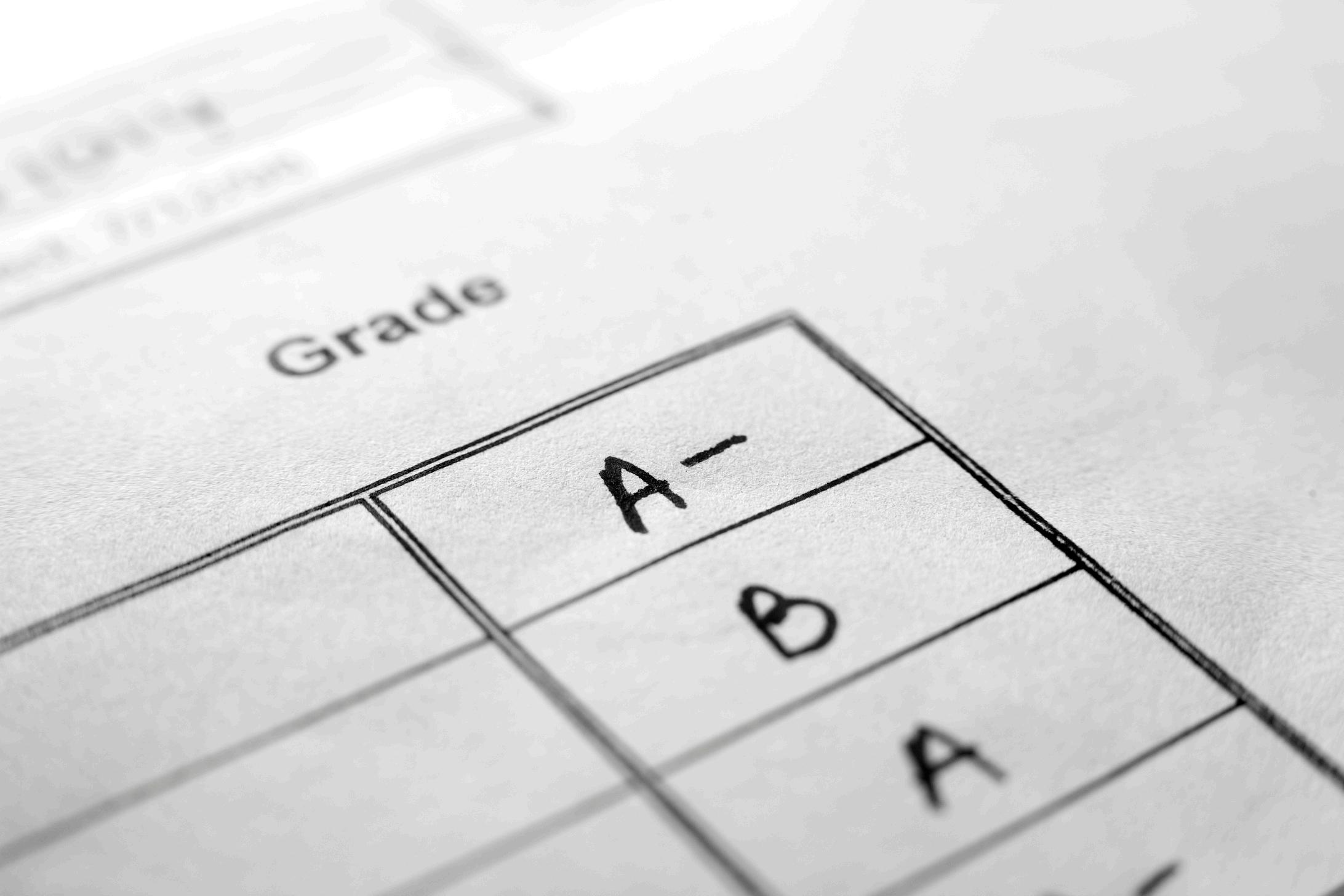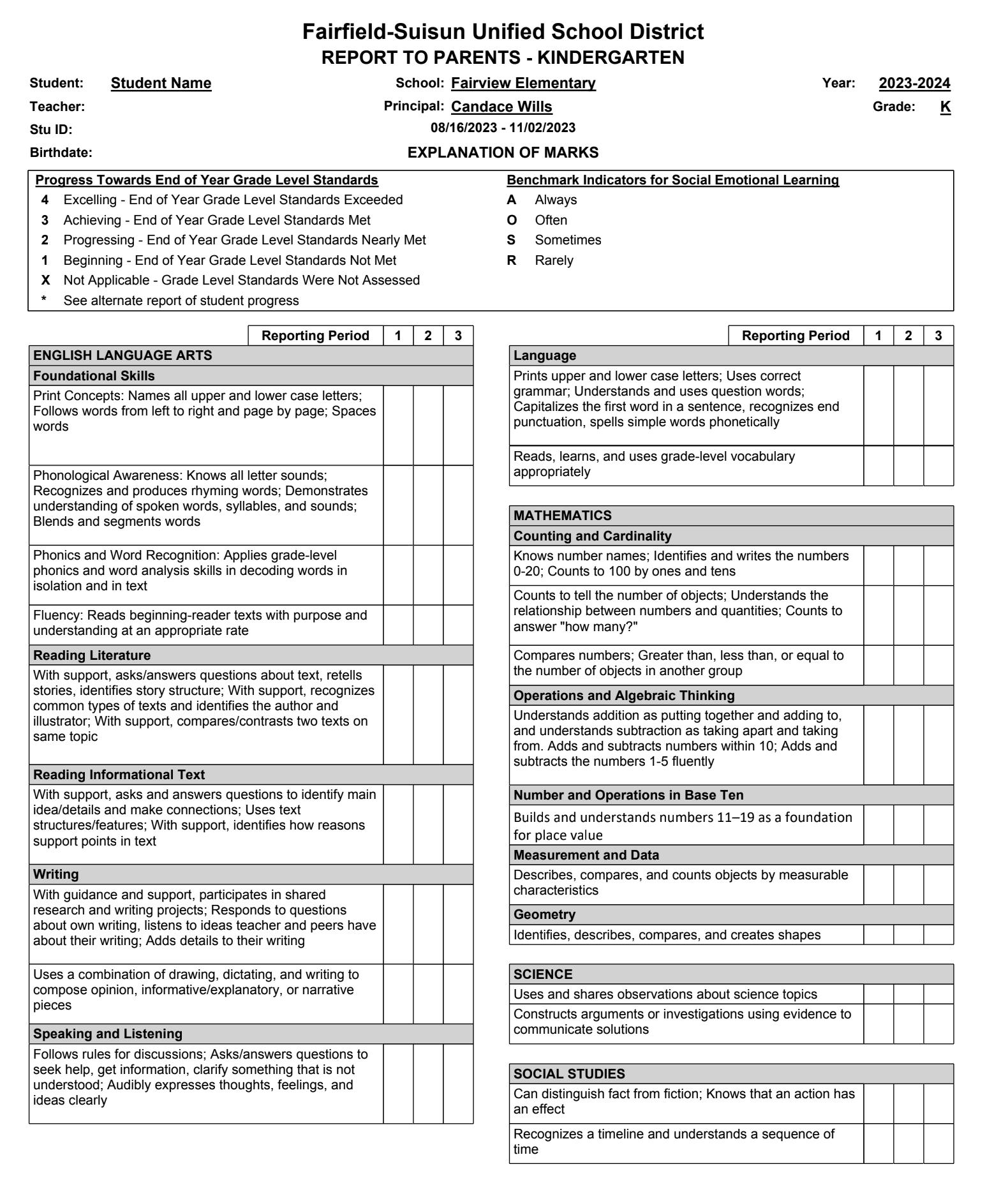







There is an exciting change coming to report cards in the 2024-2025 school year!
Fairfield-Suisun Unified School District (FSUSD) has developed Standards-Based Report Cards for students in Kindergarten-3rd grade. This transition aims to better reflect students’ progress towards meeting end-of-year grade level standards, rather than providing an overall achievement grade. The current report card prioritizes effort and soft skills over specific academic standards which is addressed in the revised format. This change is important as it supports our goal of providing every student with an equitable opportunity to learn and be successful, no matter who they are or where they go to school.
During the 2023-24 school year, the Fairfield-Suisun Unified School District Report Card Committee of district administrators, elementary principals, and elementary teachers worked together to develop the new standards-based reporting system. As part of the process, the new report cards will be implemented in grades K-3 during the 2024-25 school year and will inform the development of StandardsBased Report Cards for grades TK, 4, and 5 to be implemented during the 2025-26 school year.
We are thrilled to begin implementation across the district in grades K-3 this fall!
Starting in the 2024-25 school year, report cards for grades Kindergarten through 3rd will be updated with the following revisions:
Reflects progress towards end-of-year grade-level standards, rather than an average of grades.
Emphasizes a growth mindset.
Groups standards into categories of skills, rather than listing them individually.
Focuses on the application of skills.
Removes Achievement and Effort grades, providing marks for each standard instead.
Excludes district screener data.
Adds standards for Visual and Performing Arts (VAPA) and Physical Education (PE).
Aligns Social Emotional Learning to the CASEL framework. Includes days enrolled in the Attendance Table.
Note: Report card revisions for Transitional Kindergarten (TK), 4th, and 5th grades will be made during the 2024-25 school year and implemented in the 2025-26 school year.


Q: What is the purpose of the standards-based report card?
A: The purpose is to clearly communicate student performance toward meeting end-of-year grade-level standards and expectations to families.
Q: Why the move to a standards-based reporting system?
A: The change comes from the belief that the previous report card did not fully communicate what students are expected to know and do according to state and national standards. This new system benefits students, teachers, and families by providing a detailed outline of expectations and emphasizing learning and growth over time.
Q: How often will families be informed about students’ progress?
A: Families will receive a report card each trimester. Progress reports will be sent prior to the 1st trimester report card and at the teacher's discretion for students significantly behind in the 2nd and 3rd trimesters.
Q: If a child received all As or 4s previously, should they expect to receive all 4s in the new system?
Learning is cumulative, and the new system focuses on growth. A 4 signifies significantly exceeding end of the year standards, while a 3 shows meeting end of the year grade-level expectations, which is to be celebrated. The new system assesses learning relative to standards, unlike the previous point-based system.
A: It changes how progress is tracked and reported, making it clearer to understand a student's specific progress toward academic skills and standards. Q: How will standards-based grading affect my family?
Q: Isn’t it important for students to have a GPA?
A: In TK-5th grades, focusing on growth and mastery of skills is more beneficial than letter grades or GPA. The foundation built will prepare students for middle and high school grading systems.
Q: How will teachers determine if a student has met a standard?
A: Teachers evaluate learning through observations, student work, and assessments, using this evidence in reference with standards to inform report card marks.
Q: Should a report card assign marks for a child with a disability based on grade-level standards?
A: Yes, federal laws require that grades for students with disabilities reflect progress in the general education curriculum based on gradelevel standards, consistent with nondisabled peers.
Q: Are there any changes to the progress report?
There are changes to the progress report. The format of the progress report will reflect the report card. However, students will receive an overall progress for each content area rather than progress on each standard. The report card will reflect the progress for each content standard.



A-F represents percentage of points accumulated. Non-academic factors affect grades. All work is graded and averaged together. Early assignments can skew final grades. Reports a single grade per content area
4, 3, 2, 1 represent performance relative to standards. Reports what students know and can do. Reflects academic performance only.
Measures achievement through evidence, unaffected by extra credit or zeros.
Based on the highest level of learning demonstrated.
Teachers will use the following proficiency scale marks and descriptions on the report card to communicate student progress toward meeting essential grade level standards for all subject areas
Students at the Excelling level of performance are consistently performing at grade level, can demonstrate independence, and can extend the grade level standards expected by the end of the school year.
Students at the Achieving level of performance demonstrate an adequate understanding of and ability to apply skills needed to meet grade level standards expected by the end of the school year.
Students at the Progressing level of performance are partially meeting the grade level standards expected by the end of the school year
Students at the Beginning level of performance are not yet meeting the grade level standards expected by the end of the school year.
Students were not assessed on the grade level standards during the respective grading period.


